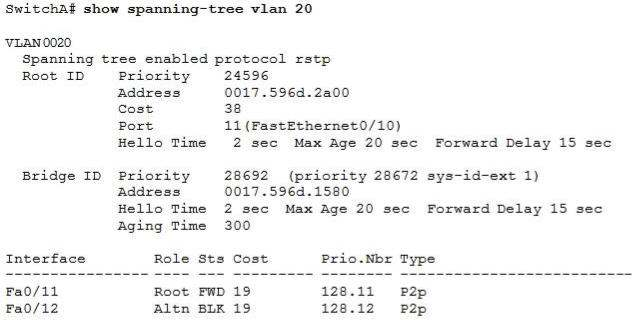QUESTION 54
Which command enables RSTP on a switch?
A. spanning-tree mode rapid-pvst
B. spanning-tree uplinkfast
C. spanning-tree backbonefast
D. spanning-tree mode mst
Correct Answer: A
QUESTION 55
Refer to the exhibit. Which statement is true?
A. The Fa0/11 role confirms that SwitchA is the root bridge for VLAN 20.
B. VLAN 20 is running the Per VLAN Spanning Tree Protocol.
C. The MAC address of the root bridge is 0017.596d.1580.
D. SwitchA is not the root bridge, because not all of the interface roles are designated.
Correct Answer: D
Explanation
Only non-root bridge can have root port. Fa0/11 is the root port so we can confirm this switch is not the root
bridge -> A is not correct.
From the output we learn this switch is running Rapid STP, not PVST -> B is not correct.
0017.596d.1580 is the MAC address of this switch, not of the root bridge. The MAC address of the root bridge
is 0017.596d.2a00 -> C is not correct.
All of the interface roles of the root bridge are designated. SwitchA has one Root port and 1 Alternative port so
it is not the root bridge -> D is correct.
QUESTION 56
Which two states are the port states when RSTP has converged? (choose two)
A. blocking
B. learning
C. disabled
D. forwarding
E. listening
Correct Answer: AD
Explanation
RSTP only has 3 port states that are discarding, learning and forwarding. When RSTP has converged there are
only 2 port states left: discarding and forwarding but the answers don’t mention about discarding state so
blocking state (answer A) may be considered the best alternative answer.
QUESTION 57
Which two of these statements regarding RSTP are correct? (Choose two)
A. RSTP cannot operate with PVST+.
B. RSTP defines new port roles.
C. RSTP defines no new port states.
D. RSTP is a proprietary implementation of IEEE 802.1D STP.
E. RSTP is compatible with the original IEEE 802.1D STP.
Correct Answer: BE
QUESTION 58
Each of these four switches has been configured with a hostname, as well as being
configured to run RSTP. No other configuration changes have been made. Which three of these show the
correct RSTP port roles for the indicated switches and interfaces?
A. SwitchA, Fa0/2, designated
B. SwitchA, Fa0/1, root
C. SwitchB, Gi0/2, root
D. SwitchB, Gi0/1, designated
E. SwitchC, Fa0/2, root
F. SwitchD, Gi0/2, root
Correct Answer: ABF
Explanation
The question says “no other configuration changes have been made” so we can understand these switches
have the same bridge priority. Switch C has lowest MAC address so it will become root bridge and 2 of its ports
(Fa0/1 & Fa0/2) will be designated ports -> E is incorrect.
Because SwitchC is the root bridge so the 2 ports nearest SwitchC on SwitchA (Fa0/1) and SwitchD (Gi0/2) will
be root ports -> B and F are correct.
Now we come to the most difficult part of this question: SwitchB must have a root port so which port will it
choose? To answer this question we need to know about STP cost and port cost.
In general, “cost” is calculated based on bandwidth of the link. The higher the bandwidth on a link, the lower the
value of its cost. Below are the cost values you should memorize:
Link speed Cost
10Mbps 100
100Mbps 19
1 Gbps 4
SwitchC advertises its cost to the root bridge with a value of 0. Switch D adds 4 (the cost value of 1Gbps link)
and advertises this value (4) to SwitchB. SwitchB adds another 4 and learns that it can reach SwitchC via Gi0/1
port with a total cost of 8. The same process happens for SwitchA and SwitchB learns that it can reach SwitchC
via Gi0/2 with a total cost of 23 -> Switch B chooses Gi0/1 as its root port -> D is not correct.
Now our last task is to identify the port roles of the ports between SwitchA & SwitchB. It is rather easy as the
MAC address of SwitchA is lower than that of SwitchB so Fa0/2 of SwitchA will be designated port while Gi0/2
of SwitchB will be alternative port -> A is correct but C is not correct.
QUESTION 59
Which item represents the standard IP ACL?
A. access-list 50 deny 192.168.1.1 0.0.0.255
B. access-list 110 permit ip any any
C. access-list 2500 deny tcp any host 192.168.1.1 eq 22
D. access-list 101 deny tcp any host 192.168.1.1
Correct Answer: A

